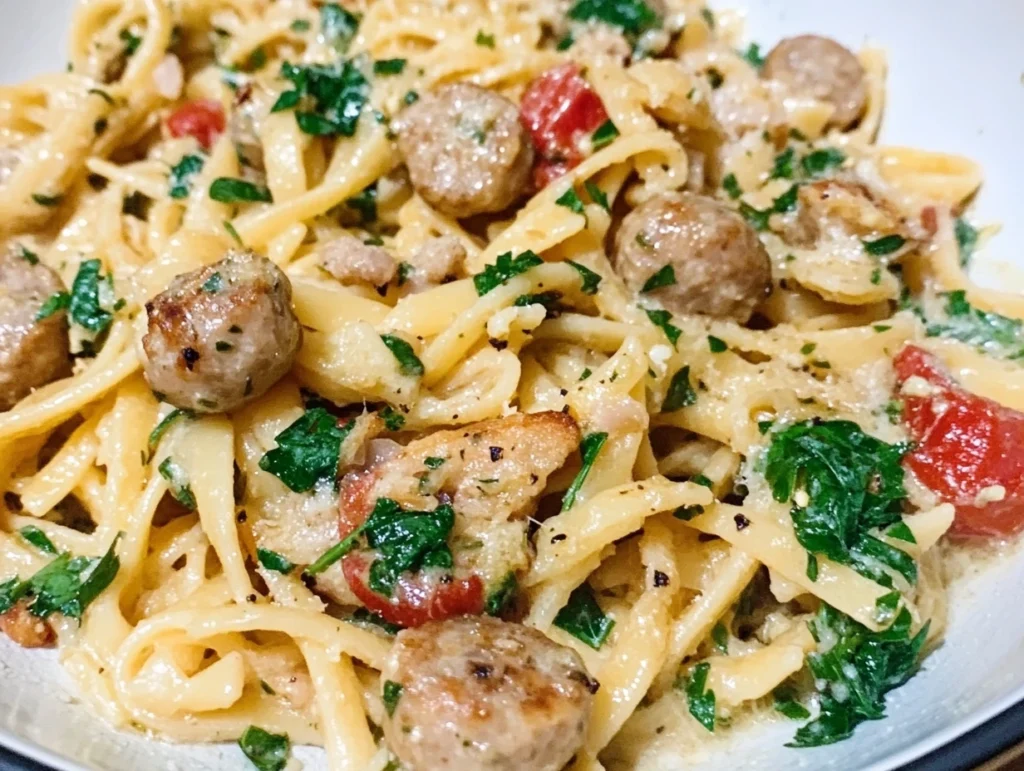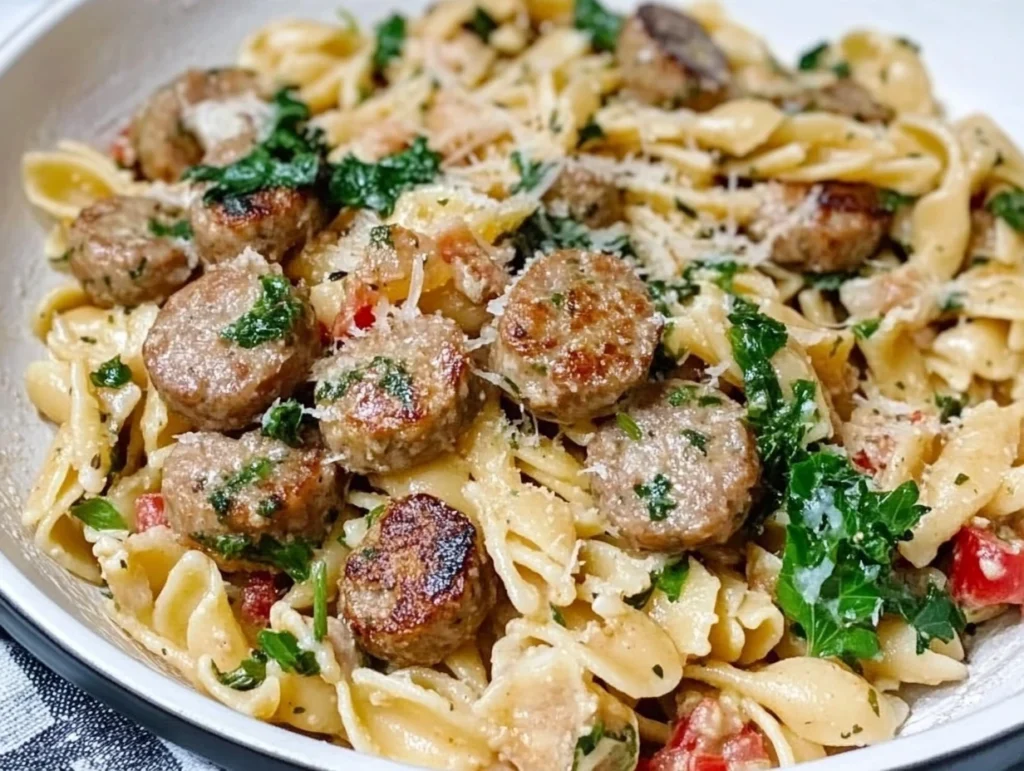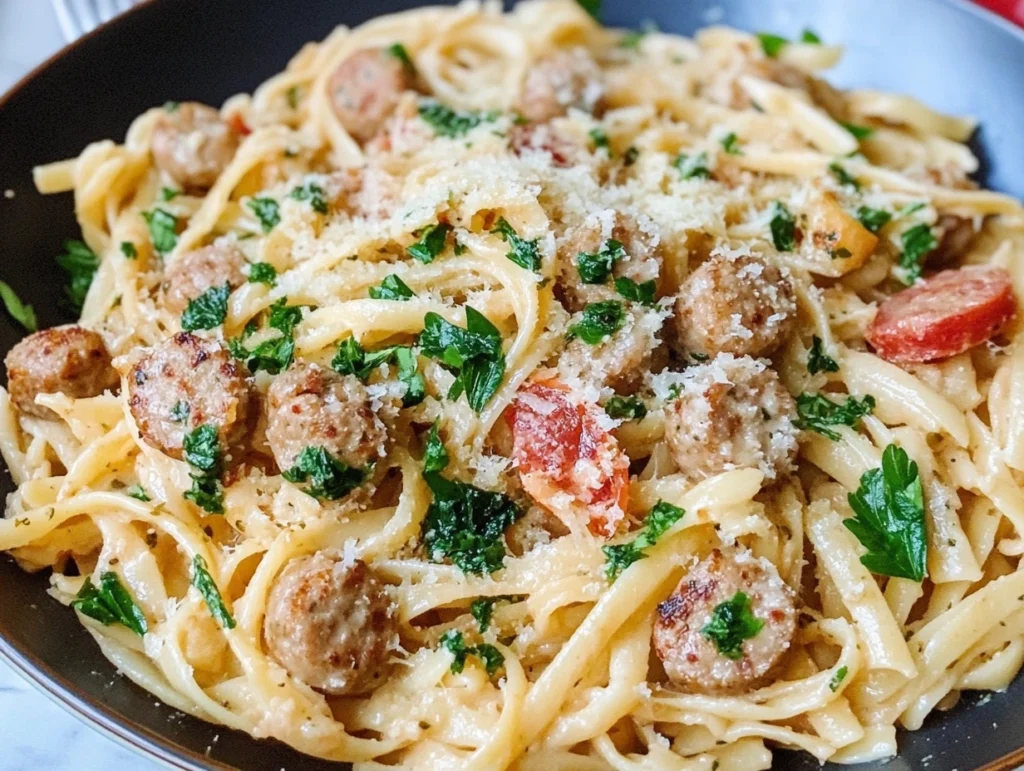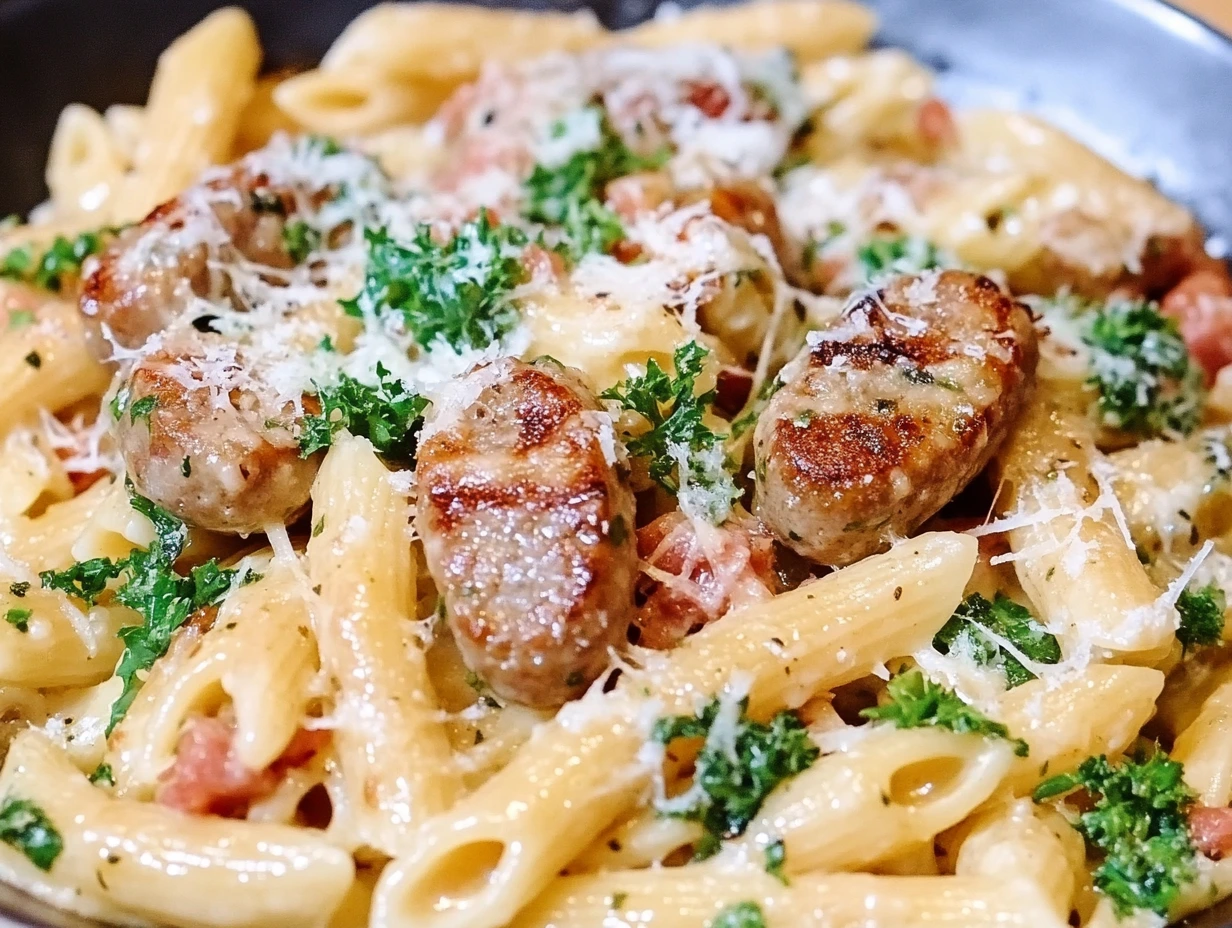Chicken sausage pasta is the perfect combination of hearty, flavorful, and wholesome ingredients, making it an excellent choice for any meal. It’s a versatile dish that balances protein, carbs, and vegetables effortlessly. Whether you’re hosting a dinner party or preparing a quick weeknight meal, this dish guarantees to impress. Plus, it’s customizable, allowing you to tweak the recipe to your liking with different pasta shapes, sauces, or spices.

Table of Contents
Essential Ingredients for Chicken Sausage Pasta
Creating a delicious chicken sausage pasta dish starts with the right ingredients. Here’s a breakdown of what you’ll need:
Choosing the Best Chicken Sausage
The star of this dish is undoubtedly the chicken sausage. When selecting the sausage:
- Opt for high-quality, all-natural chicken sausage for a healthier option.
- Look for pre-seasoned varieties like garlic herb or spicy Italian for added flavor.
- For a leaner version, consider chicken sausage with reduced fat or sodium.
Picking the Perfect Pasta Type
The choice of pasta can transform the texture and feel of your dish:
- Penne, rigatoni, or fusilli are excellent for holding sauce and toppings.
- Spaghetti or linguine works well for a lighter, silky finish.
- Whole-grain or gluten-free pasta is a great alternative for a healthier twist.
Flavorful Additions: Vegetables and Spices
Enhance your dish by adding:
- Vegetables like bell peppers, zucchini, spinach, or cherry tomatoes.
- Fresh herbs such as basil, parsley, or oregano for brightness.
- Spices like crushed red pepper flakes or smoked paprika for a bold kick.
Creamy vs. Tomato-Based Sauce: What to Choose
The choice of sauce can define the overall taste of the dish:
- Creamy Sauce: Use heavy cream or cream cheese for a rich, indulgent dish. Adding Parmesan will take it to the next level.
- Tomato-Based Sauce: Choose marinara, arrabbiata, or even diced tomatoes for a fresh, tangy flavor. You can also mix cream and tomato sauce for a creamy, tangy hybrid.
Step-by-Step Guide to Making Chicken Sausage Pasta
Preparing the Ingredients
- Gather the Essentials: Start by measuring out all the ingredients—chicken sausage, pasta, vegetables, spices, sauce ingredients, and garnishes.
- Slice the Sausage: Cut the chicken sausage into bite-sized rounds or crumble it, depending on your preference.
- Prep the Veggies: Chop vegetables like bell peppers, spinach, or cherry tomatoes into small, even pieces for quicker cooking.
- Cook the Pasta: Boil your chosen pasta in salted water until al dente. Reserve about a cup of pasta water before draining to use later in the sauce.
Cooking the Chicken Sausage
- Heat the Pan: Add a drizzle of olive oil or a small knob of butter to a large skillet over medium heat.
- Cook the Sausage: Add the sliced or crumbled chicken sausage to the skillet. Sauté for 5–7 minutes, stirring occasionally, until browned and cooked through.
- Add Garlic and Onions: Toss in minced garlic and chopped onions for an aromatic base. Sauté until fragrant and translucent.
Building the Sauce
- Choose Your Sauce: Decide between a creamy or tomato-based sauce, or opt for a combination of both.
- Deglaze the Pan: Add a splash of white wine or chicken broth to the skillet to deglaze, scraping up any flavorful browned bits from the bottom.
- Add the Sauce Ingredients:
- For Tomato Sauce: Pour in marinara or crushed tomatoes, season with Italian herbs, and simmer for 5–10 minutes.
- For Creamy Sauce: Stir in heavy cream, cream cheese, or a combination. Add grated Parmesan for richness.
- Incorporate Vegetables: Add chopped vegetables to the sauce and cook until they soften.
Combining the Pasta and Sauce
- Toss the Pasta: Add the cooked pasta to the skillet with the sauce and sausage. Stir everything together to coat the pasta evenly.
- Adjust Consistency: If the sauce is too thick, add a splash of reserved pasta water and stir until it reaches your desired consistency.
- Season to Taste: Taste the dish and adjust seasoning with salt, pepper, or red pepper flakes.
- Finish with Garnishes: Top with fresh basil, parsley, or grated Parmesan before serving.
Tips to Elevate Your Chicken Sausage Pasta
Enhancing the Flavor with Herbs and Cheese
- Fresh Herbs: Always use fresh herbs like basil, parsley, or thyme to add brightness and depth to your dish. Chop them finely and sprinkle them on just before serving for maximum aroma and flavor.
- Layered Cheese: Combine multiple types of cheese to build complexity—try Parmesan for sharpness, mozzarella for creaminess, and pecorino for a salty tang.
- Infused Oils: Drizzle a touch of herb-infused olive oil or garlic oil over the finished pasta for a gourmet finish.
- Citrus Zest: Add a hint of lemon zest to cut through the richness and brighten the flavors.
Substituting Ingredients for Dietary Preferences
- Vegetarian Option: Swap chicken sausage for plant-based sausage or sautéed mushrooms for a meaty texture and earthy flavor.
- Gluten-Free Pasta: Use gluten-free pasta made from chickpeas, lentils, or rice for a suitable alternative without compromising texture.
- Dairy-Free Sauce: Replace cream with coconut milk or a cashew-based cream for a dairy-free yet creamy consistency. Nutritional yeast can mimic the cheesy flavor.
- Low-Carb Version: Use zucchini noodles, spaghetti squash, or shirataki noodles for a lighter, low-carb option.
How to Achieve Perfectly Cooked Pasta
- Salt Your Water: Add a generous amount of salt to the boiling water—this is your only chance to season the pasta itself. The water should taste like the sea.
- Don’t Overcook: Cook the pasta al dente (slightly firm to the bite) since it will continue cooking when mixed with the sauce. Check a minute or two earlier than the package instructions.
- Reserve Pasta Water: Before draining, save about a cup of pasta water. Its starchy content helps bind the sauce to the pasta and creates a silky texture.
- Toss with Sauce: Always toss the pasta with the sauce in the skillet on low heat for a minute or two. This step ensures the flavors meld and coat every piece.

Variations of Chicken Sausage Pasta
Gluten-Free Option
- Gluten-Free Pasta: Use pasta made from rice, quinoa, lentils, or chickpeas to make the dish gluten-free while retaining a great texture.
- Sauces: Most tomato-based sauces are naturally gluten-free, but always check the labels to ensure no hidden gluten.
- Toppings: Choose gluten-free breadcrumbs or toasted nuts for a crunchy topping.
Dairy-Free and Vegan Alternatives
- Chicken Sausage Substitute: Use plant-based sausages made from soy, seitan, or pea protein to mimic the texture and flavor of chicken sausage.
- Dairy-Free Sauce: Replace cream with coconut milk, almond milk, or cashew cream. Nutritional yeast is a fantastic alternative for adding a cheesy flavor without dairy.
- Cheese Replacement: Opt for dairy-free cheeses made from cashews, soy, or almonds. Vegan Parmesan or mozzarella melts beautifully into the dish.
Spicy Chicken Sausage Pasta
- Choose Spicy Sausage: Pick chicken sausage flavored with red pepper flakes, chili, or jalapeño.
- Add Heat: Incorporate crushed red pepper flakes, cayenne pepper, or diced fresh chilies to your sauce for an extra kick.
- Balance the Spice: Add a dollop of cream or yogurt to mellow out the heat while keeping the dish flavorful.
Side Dishes That Pair Perfectly with Chicken Sausage Pasta
- Garlic Bread: A classic pairing, warm garlic bread complements the pasta’s saucy richness.
- Simple Salad: A crisp green salad with vinaigrette balances the pasta’s heartiness. Add toppings like cucumbers, cherry tomatoes, or croutons for variety.
- Roasted Vegetables: Try roasted asparagus, zucchini, or Brussels sprouts seasoned with olive oil, salt, and pepper.
- Caprese Salad: The fresh combination of mozzarella, tomatoes, basil, and balsamic glaze adds a refreshing contrast.
- Soup: Start with a light soup, like minestrone or tomato bisque, for a cozy and complete meal.
Common Mistakes to Avoid When Cooking Chicken Sausage Pasta
- Overcooking the Pasta: Cooking the pasta beyond al dente can make it mushy, especially when combined with sauce. Always check the pasta early.
- Skipping Pasta Water: Forgetting to save pasta water means missing out on a key ingredient that makes the sauce cling perfectly to the pasta.
- Not Browning the Sausage: Browning the chicken sausage enhances its flavor. Don’t rush this step!
- Using Too Much Sauce: Over-saucing can drown out the texture of the pasta. Aim for a balance where the pasta and sausage are well-coated but not swimming in sauce.
- Underseasoning: Skipping salt in the pasta water or not tasting the sauce before serving can result in a bland dish. Season at each stage for the best flavor.
- Neglecting Fresh Ingredients: Fresh herbs, cheese, and garlic can elevate the dish, so don’t rely solely on dried or pre-grated versions.

FAQs About Chicken Sausage Pasta
Can I Use Pre-Cooked Chicken Sausage?
Yes! Pre-cooked chicken sausage is a convenient option for this recipe. Simply slice it into rounds and sauté it in a skillet to heat through and develop a golden, caramelized exterior. This step adds flavor and texture to the dish.
How Do I Store Leftovers?
Store leftovers in an airtight container in the refrigerator for up to 3–4 days. Make sure the pasta is fully cooled before storing to prevent condensation and sogginess.
What’s the Best Way to Reheat the Dish?
- On the Stovetop: Place the pasta in a skillet with a splash of water or broth. Heat over medium-low heat while stirring occasionally until warmed through.
- In the Microwave: Transfer to a microwave-safe dish, cover loosely, and reheat in 30-second intervals, stirring in between to ensure even heating.
- Pro Tip: Add a touch of olive oil or grated cheese before reheating to revive the flavors and texture.
Can I Add More Vegetables?
Absolutely! This dish is highly versatile. Consider adding:
- Leafy Greens: Spinach, kale, or arugula for extra nutrition.
- Crunchy Vegetables: Bell peppers, zucchini, or broccoli for texture.
- Sweet Additions: Cherry tomatoes or caramelized onions to balance savory flavors.
You can sauté or roast the vegetables before mixing them into the pasta.
How Can I Make It Healthier?
- Use Whole-Grain or Gluten-Free Pasta: Opt for pasta made from whole wheat, quinoa, or lentils for more fiber and nutrients.
- Choose Lean Chicken Sausage: Pick a low-fat or reduced-sodium version of chicken sausage to cut down on calories and sodium.
- Go Heavy on Vegetables: Bulk up the dish with plenty of colorful veggies to make it more nutritious and filling.
- Use Lighter Sauces: Swap heavy cream for Greek yogurt, almond milk, or a simple olive oil and garlic sauce.
Which Pasta Holds the Sauce Best?
Short, ridged pasta shapes like penne, rigatoni, or fusilli are excellent choices because their grooves and curves catch and hold onto the sauce beautifully. For a creamy sauce, tagliatelle or fettuccine works well, while long noodles like spaghetti are ideal for tomato-based sauces.
To make your Chicken Sausage Pasta even more versatile, consider pairing it with other pasta-based ideas such as the rich and flavorful Creamy Sausage Pasta Recipe, which offers insights on how to create a creamy sauce variation. For those who enjoy a vegetable-forward dish, check out the tips in Sausage Broccoli Pasta Tips, which can inspire additional veggie combinations. If you’re looking to make your pasta gluten-free or explore healthy alternatives, the suggestions from Chicken Slow Cooker Recipes (Gluten-Free) might be a helpful guide.
Conclusion
Chicken sausage pasta is a delightful, versatile dish that brings together wholesome ingredients, bold flavors, and a variety of customizable options. Whether you prefer a creamy or tomato-based sauce, gluten-free pasta, or a spicy twist, this recipe has something for everyone. By following the step-by-step guide, incorporating helpful tips, and exploring creative variations, you can elevate this simple dish into a restaurant-quality meal. Pair it with the perfect side dishes and avoid common mistakes to ensure every bite is as satisfying as the last.
With endless opportunities to experiment and personalize, chicken sausage pasta is sure to become a favorite in your kitchen. So gather your ingredients, try it today, and enjoy a meal that’s as quick as it is flavorful!

